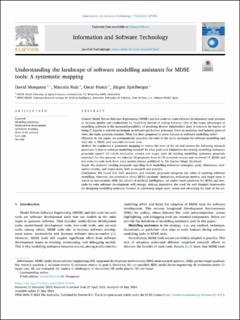Please use this identifier to cite or link to this item:
https://doi.org/10.21256/zhaw-30735Full metadata record
| DC Field | Value | Language |
|---|---|---|
| dc.contributor.author | Mosquera, David | - |
| dc.contributor.author | Ruiz, Marcela | - |
| dc.contributor.author | Pastor, Oscar | - |
| dc.contributor.author | Spielberger, Jürgen | - |
| dc.date.accessioned | 2024-05-30T12:56:02Z | - |
| dc.date.available | 2024-05-30T12:56:02Z | - |
| dc.date.issued | 2024 | - |
| dc.identifier.issn | 0950-5849 | de_CH |
| dc.identifier.uri | https://digitalcollection.zhaw.ch/handle/11475/30735 | - |
| dc.description.abstract | Context: Model Driven Software Engineering (MDSE) and low-code/no-code software development tools promise to increase quality and productivity by modelling instead of coding software. One of the major advantages of modelling software is the increased possibility of involving diverse stakeholders since it removes the barrier of being IT experts to actively participate in software production processes. From an academic and industry point of view, the main question remains: What has been proposed to assist humans in software modelling tasks? Objective: In this paper, we systematically elucidate the state of the art in assistants for software modelling and their use in MDSE and low-code/no-code tools. Method: We conducted a systematic mapping to review the state of the art and answer the following research questions: i) how is software modelling assisted? ii) what goals and limitations do existing modelling assistance proposals report? iii) which evaluation metrics and target users do existing modelling assistance proposals consider? For this purpose, we selected 58 proposals from 3.176 screened records and reviewed 17 MDSE and low-code/no-code tools from main market players published by the Gartner Magic Quadrant. Result: We clustered existing proposals regarding their modelling assistance strategies, goals, limitations, evaluation metrics, and target users, both in research and practice. Conclusions: We found that both academic and industry proposals recognise the value of assisting software modelling. However, documentation about MDSE assistants’ limitations, evaluation metrics, and target users is scarce or non-existent. With the advent of artificial intelligence, we expect more assistants for MDSE and low-code/no-code software development will emerge, making imperative the need for well-founded frameworks for designing modelling assistants focused on addressing target users’ needs and advancing the state of the art. | de_CH |
| dc.language.iso | en | de_CH |
| dc.publisher | Elsevier | de_CH |
| dc.relation.ispartof | Information and Software Technology | de_CH |
| dc.rights | https://creativecommons.org/licenses/by/4.0/ | de_CH |
| dc.subject | Modelling assistance | de_CH |
| dc.subject | Model-driven development | de_CH |
| dc.subject | Systematic mapping | de_CH |
| dc.subject | State of the practice | de_CH |
| dc.subject | Low code | de_CH |
| dc.subject | No-code | de_CH |
| dc.subject.ddc | 005: Computerprogrammierung, Programme und Daten | de_CH |
| dc.title | Understanding the landscape of software modelling assistants for MDSE tools : a systematic mapping | de_CH |
| dc.type | Beitrag in wissenschaftlicher Zeitschrift | de_CH |
| dcterms.type | Text | de_CH |
| zhaw.departement | School of Engineering | de_CH |
| zhaw.organisationalunit | Institut für Informatik (InIT) | de_CH |
| dc.identifier.doi | 10.1016/j.infsof.2024.107492 | de_CH |
| dc.identifier.doi | 10.21256/zhaw-30735 | - |
| zhaw.funding.eu | No | de_CH |
| zhaw.issue | 107492 | de_CH |
| zhaw.originated.zhaw | Yes | de_CH |
| zhaw.publication.status | publishedVersion | de_CH |
| zhaw.volume | 173 | de_CH |
| zhaw.publication.review | Peer review (Publikation) | de_CH |
| zhaw.webfeed | Software Engineering | de_CH |
| zhaw.funding.zhaw | Smart Hospital – Integrated Framework, Tools & Solutions (SHIFT) | de_CH |
| zhaw.author.additional | No | de_CH |
| zhaw.display.portrait | Yes | de_CH |
| zhaw.relation.references | https://doi.org/10.5281/zenodo.10671287 | de_CH |
| Appears in collections: | Publikationen School of Engineering | |
Files in This Item:
| File | Description | Size | Format | |
|---|---|---|---|---|
| 2024_Mosquera-etal_Software-modelling-assistants-landscape-for-MDSE-tools.pdf | 9.05 MB | Adobe PDF |  View/Open |
Show simple item record
Mosquera, D., Ruiz, M., Pastor, O., & Spielberger, J. (2024). Understanding the landscape of software modelling assistants for MDSE tools : a systematic mapping. Information and Software Technology, 173(107492). https://doi.org/10.1016/j.infsof.2024.107492
Mosquera, D. et al. (2024) ‘Understanding the landscape of software modelling assistants for MDSE tools : a systematic mapping’, Information and Software Technology, 173(107492). Available at: https://doi.org/10.1016/j.infsof.2024.107492.
D. Mosquera, M. Ruiz, O. Pastor, and J. Spielberger, “Understanding the landscape of software modelling assistants for MDSE tools : a systematic mapping,” Information and Software Technology, vol. 173, no. 107492, 2024, doi: 10.1016/j.infsof.2024.107492.
MOSQUERA, David, Marcela RUIZ, Oscar PASTOR und Jürgen SPIELBERGER, 2024. Understanding the landscape of software modelling assistants for MDSE tools : a systematic mapping. Information and Software Technology. 2024. Bd. 173, Nr. 107492. DOI 10.1016/j.infsof.2024.107492
Mosquera, David, Marcela Ruiz, Oscar Pastor, and Jürgen Spielberger. 2024. “Understanding the Landscape of Software Modelling Assistants for MDSE Tools : A Systematic Mapping.” Information and Software Technology 173 (107492). https://doi.org/10.1016/j.infsof.2024.107492.
Mosquera, David, et al. “Understanding the Landscape of Software Modelling Assistants for MDSE Tools : A Systematic Mapping.” Information and Software Technology, vol. 173, no. 107492, 2024, https://doi.org/10.1016/j.infsof.2024.107492.
Items in DSpace are protected by copyright, with all rights reserved, unless otherwise indicated.